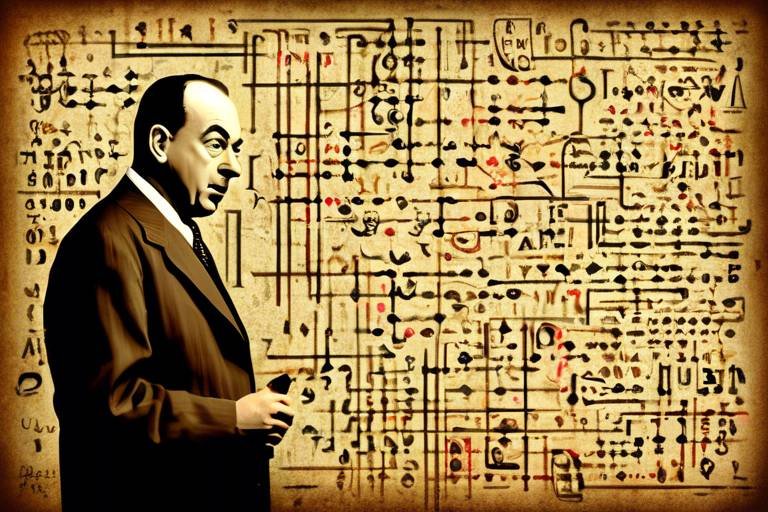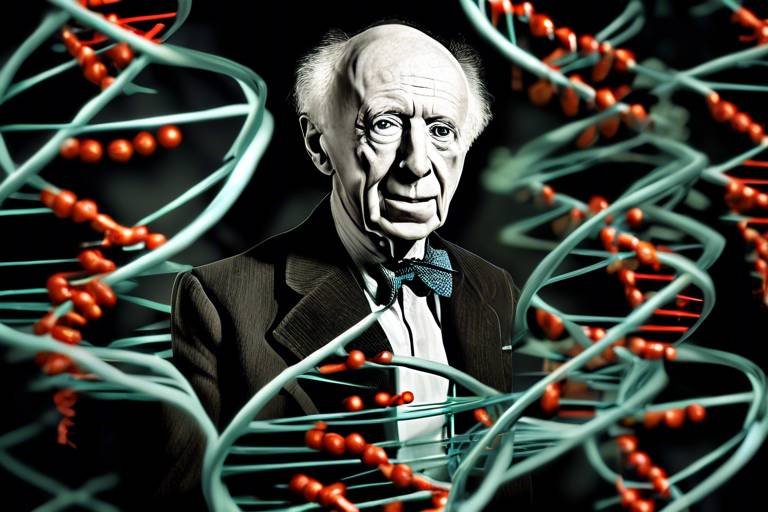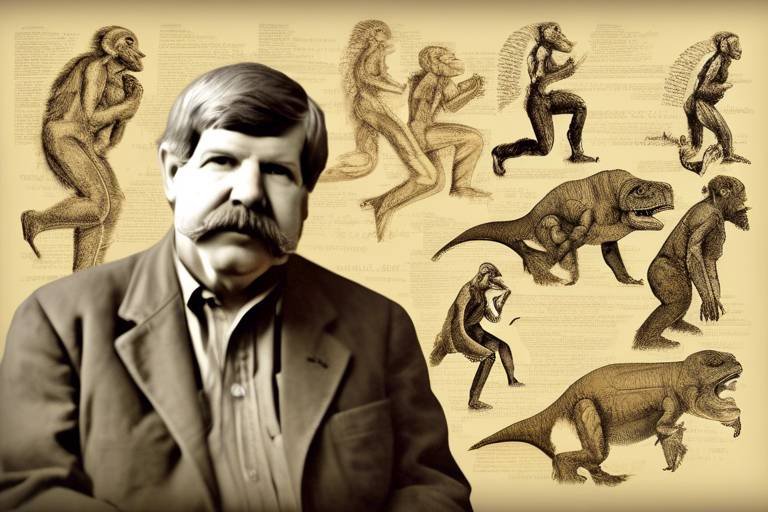The Life of Archimedes and His Mathematical Innovations
Archimedes, a name that resonates through the corridors of history, was not just a mathematician; he was a revolutionary thinker whose ideas shaped the very foundations of science and engineering. Born in Syracuse, Sicily, around 287 BC, Archimedes was a true polymath, dabbling in various fields, including mathematics, physics, engineering, and astronomy. His life was a tapestry woven with curiosity, intellect, and an insatiable desire to understand the world around him. Imagine a time when the concept of zero was still a mystery, yet here was a man who could calculate the area of a circle with stunning precision! His innovations didn’t just stay confined to his time; they exploded into the future, influencing countless generations of thinkers, scientists, and engineers.
What makes Archimedes particularly fascinating is his approach to problem-solving. He didn’t just accept the status quo; instead, he challenged existing beliefs and sought to uncover the underlying principles that governed the physical world. His legendary quote, "Give me a place to stand, and I shall move the Earth," epitomizes his understanding of leverage and mechanics. Think about it: a simple lever, when used correctly, can lift immense weights. This principle wasn’t just theoretical; it had practical applications that changed the landscape of engineering forever.
Throughout his life, Archimedes made remarkable contributions that can still be seen in modern mathematics and physics. His work laid the groundwork for concepts like buoyancy and the lever, which are fundamental in both theoretical and applied sciences today. But what truly sets Archimedes apart is his ability to blend rigorous mathematical reasoning with practical applications. He wasn't just crunching numbers; he was thinking critically about how those numbers applied to the real world.
As we delve deeper into the life of Archimedes, we’ll explore his early education, his groundbreaking mathematical contributions, and the legacy he left behind. From the principles of levers to the method of exhaustion in geometry, Archimedes' innovations are a testament to human ingenuity. Join me on this journey through time as we uncover the life and works of one of history's greatest minds.
- What are Archimedes' most famous inventions?
Archimedes is known for several inventions, including the Archimedean screw, a device for raising water, and the compound pulley system that allows heavy loads to be lifted with minimal effort. - How did Archimedes contribute to calculus?
Archimedes developed the method of exhaustion, which was a precursor to integral calculus, allowing for the approximation of areas and volumes. - What is the significance of Archimedes' principle of buoyancy?
This principle explains how objects submerged in fluid experience an upward force, which is crucial in understanding how ships float and how various objects behave in water. - Why is Archimedes considered a pioneer of mathematics?
His innovative approaches and methods laid the groundwork for future mathematicians and scientists, influencing fields such as physics, engineering, and geometry.

Early Life and Education
Archimedes was born in Syracuse, Sicily, around 287 BC. His birthplace played a significant role in shaping his intellectual pursuits, as Syracuse was a hub of culture and knowledge during that time. From an early age, Archimedes exhibited a natural curiosity and a remarkable aptitude for mathematics and science. His family background, likely connected to the ruling class of Syracuse, provided him with access to education that was not available to most.
To further his studies, Archimedes traveled to Alexandria, Egypt, which was renowned for its great library and scholarly community. This city was a melting pot of ideas and innovations, attracting some of the brightest minds of the ancient world. It was here that Archimedes encountered the works of great mathematicians and philosophers, such as Euclid. The rigorous training he received in Alexandria not only honed his mathematical skills but also ignited his passion for inquiry and experimentation.
During his time in Alexandria, Archimedes delved into various subjects, including geometry, physics, and engineering. The influence of his education is evident in his later works, where he applied mathematical concepts to solve real-world problems. For instance, he learned about the significance of mathematical proofs, which became a cornerstone of his methodology. Archimedes was particularly fascinated by the geometry of circles and the properties of levers, which would later lead to his groundbreaking discoveries.
Archimedes' education was not limited to formal studies; he actively engaged in discussions and debates with contemporaries, which helped refine his thinking. His relentless pursuit of knowledge and understanding was akin to a sculptor chiseling away at a block of marble, revealing the masterpiece hidden within. This intellectual environment fostered a spirit of innovation that would characterize his later contributions to mathematics and science.
In summary, Archimedes' early life and education laid a strong foundation for his future achievements. The combination of his innate talent, access to a rich educational environment, and his relentless curiosity propelled him into becoming one of the most influential figures in the history of mathematics. His journey from Syracuse to Alexandria not only shaped his understanding of mathematics but also set the stage for his revolutionary ideas that continue to resonate in modern science.
- What were Archimedes' main contributions to mathematics? Archimedes contributed significantly to geometry, calculus, and mechanics, particularly through his principles of levers and buoyancy.
- Where did Archimedes study? Archimedes studied in Alexandria, Egypt, which was a major center of learning in the ancient world.
- Why is Archimedes considered a pioneer? He is considered a pioneer due to his innovative methods and principles that laid the groundwork for modern mathematics and physics.

Key Mathematical Contributions
Archimedes was not just a mathematician; he was a trailblazer whose insights laid the foundation for many modern scientific principles. His contributions to mathematics are nothing short of revolutionary, impacting fields such as physics, engineering, and even economics. One of his most significant advancements was the formulation of the principles of lever and buoyancy, which transformed our understanding of mechanics. Imagine trying to lift a massive boulder with nothing but a stick; Archimedes showed us how a simple lever could make that feat possible. His work allowed humans to manipulate heavy objects with ease, fundamentally changing the way we approach construction and engineering.
In addition to levers, Archimedes made remarkable strides in calculating the areas and volumes of various shapes. He was particularly fascinated with circles and spheres, leading him to develop formulas that are still taught in schools today. For instance, he discovered that the area of a circle is equal to π times the square of its radius. This was a groundbreaking finding that not only helped in theoretical mathematics but also had practical applications in architecture and engineering.
The principle of levers is one of Archimedes' most famous contributions. He famously stated, "Give me a place to stand, and I shall move the Earth." This quote encapsulates the essence of his discovery: a lever amplifies an applied force, allowing a small effort to lift a heavy load. This principle is not just theoretical; it has real-world applications. For example, in construction, cranes utilize this principle to lift enormous weights with minimal effort. The mechanics behind this are simple yet profound, demonstrating how a small input can lead to a large output. It's like using a seesaw; with the right positioning, even a child can lift an adult!
Archimedes' principle of levers found numerous applications in ancient engineering. The design of cranes, pulleys, and various lifting devices owes much to his insights. For instance, the construction of the great pyramids in Egypt would have been nearly impossible without the understanding of levers and pulleys. Today, we still rely on these principles in modern machinery, from construction equipment to elevators. The fundamental mechanics that Archimedes described continue to be relevant, proving that his ideas have stood the test of time.
Not only did Archimedes revolutionize ancient engineering, but his understanding of levers also laid the groundwork for modern physics. The principles he outlined are foundational concepts used in the study of mechanics and the design of complex machines. Think about it: every time you use a seesaw or even ride a bike, you are experiencing the principles that Archimedes so elegantly explained. His work serves as a bridge between ancient wisdom and modern scientific inquiry, influencing scholars and inventors for centuries.
Another remarkable contribution from Archimedes is the principle of buoyancy, which explains how objects submerged in fluid experience an upward force equal to the weight of the fluid displaced. This principle has profound implications in hydrostatics and helps us understand why ships float and how submarines dive. When Archimedes famously shouted "Eureka!" upon discovering this principle, he was not just celebrating a personal victory; he was unveiling a fundamental truth about the physical world. This discovery has applications ranging from naval engineering to fluid dynamics, showcasing the far-reaching impact of his work.

Principle of Levers
The , discovered by the brilliant mind of Archimedes, is a concept that has transformed our understanding of mechanics. Imagine trying to lift a massive stone block with just your bare hands. It seems impossible, right? But with the right tool—a lever—you can easily lift that heavy load with minimal effort. This principle states that a lever amplifies an applied force, allowing a small effort to lift a heavy load. To put it simply, it’s like using a seesaw in the playground; when you sit on one end, your friend can lift you up with just a little push on the other side. This revolutionary idea not only changed the way we think about lifting but also paved the way for numerous mechanical innovations.
Archimedes articulated this principle with remarkable clarity. He famously said, "Give me a place to stand, and I shall move the Earth." This quote encapsulates the essence of levers—if you have the right leverage, almost anything is possible. The lever consists of three parts: the fulcrum (the pivot point), the effort (the force applied), and the load (the weight to be moved). The position of these components determines how effectively the lever can amplify force. For instance, moving the fulcrum closer to the load requires less effort to lift it, demonstrating the power of leverage.
In ancient engineering, Archimedes' principle of levers found applications in various devices, such as cranes and pulleys. These innovations were crucial for constructing monumental structures, allowing builders to move heavy stones with ease. The design of cranes, for example, is heavily influenced by the lever principle, enabling operators to lift and position massive loads with precision. Today, the principles derived from Archimedes' work are still relevant, as they form the backbone of modern engineering and mechanics.
Moreover, the influence of the principle of levers extends beyond engineering into the realm of modern physics. It has provided foundational concepts that are essential in the study of mechanics and the design of complex machines. Engineers and physicists alike rely on these principles to create everything from simple tools to advanced machinery. In essence, Archimedes' insights into levers have not only stood the test of time but have also become integral to our understanding of the physical world.
In conclusion, the principle of levers is a testament to Archimedes' genius. His ability to distill complex ideas into practical applications has left a lasting legacy that continues to inspire innovation. Whether you’re lifting a heavy object or designing intricate machinery, the principles of leverage remind us of the power of ingenuity and the importance of looking for solutions beyond brute force.
- What is the principle of levers? The principle of levers states that a lever amplifies an applied force, allowing a small effort to lift a heavy load.
- How did Archimedes discover the principle of levers? Archimedes discovered this principle through observation and experimentation with simple machines, leading to profound insights into mechanics.
- What are some modern applications of the principle of levers? Modern applications include cranes, pulleys, and various mechanical devices that rely on leverage to function efficiently.
- Why is the principle of levers important? It is important because it provides a fundamental understanding of mechanics, enabling the design of tools and machines that enhance our ability to perform work.

Applications in Engineering
Archimedes' groundbreaking principles, particularly his principle of levers, have had an enduring influence on engineering practices throughout history. The idea that a small force can be used to lift a heavy load was revolutionary and laid the foundation for various mechanical devices. Imagine trying to lift a massive stone block without any tools—almost impossible! But with the lever, a mere child could lift a boulder with just a little push. This principle is not only fundamental in mechanics but also serves as the backbone for many modern engineering applications.
One of the most significant applications of Archimedes' principles can be found in the design and construction of cranes. These towering machines, essential for lifting heavy materials in construction sites, rely heavily on the mechanics of levers. By utilizing a long arm as a lever, cranes can amplify the force applied at one end to lift substantial weights at the other. This innovation not only makes construction feasible but also safe and efficient.
Additionally, Archimedes' work has influenced the development of pulleys, which are systems of levers that allow for the easy lifting of loads. A simple arrangement of ropes and wheels can drastically reduce the effort needed to lift heavy objects. For instance, when you pull down on one side of a pulley system, you can effortlessly lift a load on the opposite side. This ingenious application of levers demonstrates how Archimedes' ideas have permeated various engineering solutions.
Moreover, the principles laid out by Archimedes have found their way into modern machinery. Engineers today apply these concepts in designing complex machines, such as elevators and hoists, which rely on the same fundamental principles of leverage. The efficiency gained through these designs has transformed industries, making tasks that once required immense physical strength now manageable with minimal effort.
To further illustrate the impact of Archimedes' principles in engineering, consider the following table that highlights various applications:
| Application | Description | Archimedean Principle Used |
|---|---|---|
| Cranes | Machines designed to lift heavy materials at construction sites. | Lever Principle |
| Pulleys | Systems that allow for the lifting of loads with reduced effort. | Lever Principle |
| Elevators | Vertical transport systems that move people and goods between floors. | Lever Principle |
| Hoists | Devices used for lifting or lowering heavy loads. | Lever Principle |
In summary, the applications of Archimedes' principles in engineering are vast and varied, showcasing the timelessness of his insights. From cranes to pulleys, the fundamental ideas he introduced continue to shape the way we build and create. Without his contributions, the engineering marvels we see today might not have been possible, highlighting the importance of understanding and applying the principles of mechanics.
- What is Archimedes' principle of levers?
Archimedes' principle of levers states that a lever amplifies an applied force, allowing a smaller force to lift a heavier load. - How did Archimedes influence modern engineering?
His principles of mechanics, especially regarding levers, have been foundational in designing cranes, pulleys, and various lifting devices. - What are some modern applications of Archimedes' principles?
Modern applications include cranes, elevators, hoists, and any machinery that uses levers to amplify force.

Influence on Modern Physics
Archimedes' contributions to the understanding of levers and buoyancy have had a profound impact on modern physics. His principles, which were revolutionary in their time, laid the groundwork for many concepts that we now take for granted in the study of mechanics. Imagine trying to lift a massive stone block without understanding the mechanics of levers; it would be akin to trying to swim against a raging river without knowing how to float. Archimedes made it possible to harness the power of simple machines, transforming our approach to physical challenges.
One of the most significant ways Archimedes' work influences modern physics is through the principle of levers. This principle states that a lever amplifies an applied force, allowing a smaller effort to lift a larger weight. In today’s world, this concept is not just theoretical; it is applied in various fields, from construction to robotics. For example, cranes utilize the principles of levers to lift heavy loads with minimal effort. Without Archimedes' insights, the development of such machinery would have been severely hindered.
Moreover, Archimedes' principle of buoyancy has paved the way for advancements in fluid dynamics. The idea that an object submerged in a fluid experiences an upward force equal to the weight of the fluid displaced is fundamental in various applications, including ship design and underwater exploration. For instance, naval architects rely on this principle to ensure that vessels are designed to float and navigate effectively, avoiding the pitfalls of capsizing or sinking.
To illustrate the significance of Archimedes' contributions, consider the following table that summarizes the key principles he introduced and their modern applications:
| Principle | Modern Application |
|---|---|
| Principle of Levers | Cranes, Pulleys, Robotics |
| Principle of Buoyancy | Ship Design, Submarine Engineering |
| Hydrostatic Pressure | Fluid Dynamics, Engineering Structures |
In essence, Archimedes' work acts as a bridge between ancient mechanics and modern physics. His insights have not only influenced theoretical physics but have also been instrumental in practical applications that shape our daily lives. When we consider how much we rely on technology that employs these principles, it becomes clear that Archimedes' legacy is not merely historical; it is a living part of our scientific heritage that continues to inspire innovation and discovery.
- What are Archimedes' most famous contributions? Archimedes is known for his principles of levers and buoyancy, as well as his work on the area and volume of geometric shapes.
- How did Archimedes influence modern engineering? His principles of mechanics are foundational in the design and operation of various machines, including cranes and pulleys.
- What is the significance of the principle of buoyancy? It explains why objects float in fluids and is crucial in fields like naval architecture and fluid dynamics.

Archimedes' Principle of Buoyancy
Imagine you're at the beach, enjoying the sun and the waves. You decide to take a plunge into the water, and as you do, you feel that familiar sensation—it's as if the water is lifting you up. This magical feeling isn't just a coincidence; it's all thanks to a brilliant mind named Archimedes. Born in ancient Syracuse, Archimedes formulated what we now call the Principle of Buoyancy, a fundamental concept that explains why objects float or sink in fluids.
So, what exactly is this principle? In simple terms, Archimedes discovered that when an object is submerged in a fluid, it experiences an upward force equal to the weight of the fluid it displaces. This means that if you push something into the water, the water pushes back with a force that can make it float. It's like a game of tug-of-war between gravity and the water's upward push!
To put this into perspective, consider the following example: if you drop a rock into a pool, it sinks. This happens because the weight of the rock is greater than the weight of the water it displaces. Conversely, when you toss a beach ball into the same pool, it floats. Here, the upward force from the water is greater than the weight of the beach ball, allowing it to stay on the surface. This fascinating interplay of forces is what makes swimming and boating possible, and it's a testament to Archimedes' genius.
Archimedes' Principle of Buoyancy has profound implications not just in everyday life, but also in various fields such as engineering and naval architecture. Engineers use this principle to design ships and submarines, ensuring they can carry loads safely while navigating through water. The formula can even help predict how much weight a boat can carry before it starts to sink.
To summarize the key aspects of Archimedes' Principle of Buoyancy, consider the following table:
| Aspect | Description |
|---|---|
| Displacement | The volume of fluid displaced by the submerged object. |
| Upward Force | The buoyant force acting on the object, equal to the weight of the displaced fluid. |
| Floating Condition | An object floats if its weight is less than the weight of the fluid it displaces. |
| Sinking Condition | An object sinks if its weight is greater than the weight of the fluid it displaces. |
In conclusion, Archimedes' Principle of Buoyancy is not just a theoretical concept; it is a practical tool that has shaped our understanding of fluid dynamics. Whether you're a scientist, an engineer, or just someone who enjoys a day at the pool, this principle is at work in your life every day. So, the next time you take a swim, remember the genius of Archimedes and the invisible forces that allow you to float!
- What is Archimedes' Principle of Buoyancy?
It states that an object submerged in a fluid experiences an upward force equal to the weight of the fluid displaced. - How does this principle apply to ships?
It helps engineers determine how much weight a ship can safely carry before it begins to sink. - Can Archimedes' principle be applied to gases?
Yes, it applies to any fluid, including gases, which is why hot air balloons can float in the air.

Innovations in Geometry
Archimedes was not just a mathematician; he was a true pioneer in the realm of geometry. His groundbreaking innovations laid the foundation for modern geometric principles, and his methods are still taught in classrooms around the world today. One of his most significant contributions is the calculation of the areas and volumes of various shapes, including circles, spheres, and cylinders. Imagine trying to determine how much water can fill a uniquely shaped container without the tools we have today—Archimedes made that possible through his ingenious methods.
One of the standout techniques developed by Archimedes is the Method of Exhaustion. This method is essentially an early form of integral calculus, allowing him to approximate the area of a circle by inscribing and circumscribing polygons. By increasing the number of sides of these polygons, Archimedes could get closer and closer to the true area of the circle. It's like trying to fit a perfect circle inside a series of increasingly complex shapes—each time you add more sides, you get a clearer picture of the circle's area. This method was revolutionary and paved the way for future mathematicians to explore calculus in greater depth.
Another fascinating aspect of Archimedes’ work in geometry is his classification of Archimedean Solids. These solids are a group of highly symmetrical shapes that exhibit unique geometric properties. They are not only mathematically significant but also visually stunning, capturing the imagination of both mathematicians and artists alike. To give you an idea of their importance, here’s a brief overview of some of the most well-known Archimedean solids:
| Solid Name | Number of Faces | Symmetry |
|---|---|---|
| Cuboctahedron | 8 triangles, 6 squares | High |
| Dodecahedron | 12 pentagons | Very High |
| Icosidodecahedron | 20 triangles, 12 pentagons | Very High |
These solids not only contributed to the field of geometry but also influenced art and architecture throughout history. Think about how many structures today are inspired by these forms—everything from modern buildings to sculptures draws on the principles that Archimedes explored. His work reminds us that mathematics is not just a collection of numbers and formulas; it’s a language that helps us understand and shape the world around us.
In conclusion, Archimedes’ innovations in geometry have left an indelible mark on both mathematics and the sciences. His methods, particularly the Method of Exhaustion and his study of Archimedean solids, have provided tools and concepts that continue to inspire and educate. As you delve into the world of geometry, remember that you are standing on the shoulders of a giant who saw the beauty and utility of shapes long before most of us could even grasp their significance.
- What is the Method of Exhaustion? The Method of Exhaustion is an early form of integral calculus developed by Archimedes to approximate the area and volume of shapes by inscribing and circumscribing polygons.
- What are Archimedean solids? Archimedean solids are a group of highly symmetrical three-dimensional shapes characterized by their regular faces and uniform vertex arrangements.
- How did Archimedes influence modern geometry? Archimedes’ methods and principles laid the groundwork for future developments in geometry and calculus, influencing countless mathematicians and scientists.

Method of Exhaustion
The is one of Archimedes' most significant contributions to mathematics, and it truly showcases his genius. Imagine trying to find the area of a circle or the volume of a sphere without the tools we have today. Archimedes tackled these complex problems using a remarkably innovative approach that involved inscribing and circumscribing polygons around the shapes in question. By doing so, he could approximate the area or volume more accurately as the number of polygon sides increased.
This method operates on a simple yet powerful principle: as you increase the number of sides of the polygons, their area gets closer and closer to the area of the circle or the volume of the sphere. Think of it like trying to fit a perfectly smooth circle with a series of straight-edged polygons. The more sides you add, the closer you get to matching the circle's curvature. This idea is a precursor to what we now know as integral calculus.
Archimedes used this technique to calculate the areas and volumes of various geometric shapes, making significant advancements in mathematics. For instance, he was able to determine that the area of a circle is equal to π times the square of its radius. This was a groundbreaking discovery that laid the foundation for future mathematical studies. To put it simply, Archimedes didn't just stop at finding answers; he developed a systematic method that would influence mathematicians for centuries to come.
To illustrate the concept, let's take a look at how Archimedes might have approached the area of a circle:
| Number of Sides | Approximate Area |
|---|---|
| 3 (Triangle) | 1.5 |
| 4 (Square) | 2.0 |
| 6 (Hexagon) | 2.6 |
| 8 (Octagon) | 3.1 |
| 12 (Dodecagon) | 3.5 |
| ∞ (Circle) | πr² |
As you can see from the table, as the number of sides increases, the approximate area of the polygon approaches the true area of the circle. This method not only helped Archimedes solve problems of his time but also paved the way for future mathematicians to explore and expand upon these concepts. His work with the Method of Exhaustion is a perfect example of how curiosity and creativity can lead to profound discoveries that resonate through time.
- What is the Method of Exhaustion?
The Method of Exhaustion is a technique used by Archimedes to find the area and volume of shapes by approximating them with polygons.
- How did Archimedes use this method?
He inscribed and circumscribed polygons around the shapes, increasing the number of sides to get closer to the area or volume of the original shape.
- Why is this method important?
This method laid the groundwork for integral calculus and has influenced mathematical thought for centuries.

Archimedean Solids
When you think of geometry, what comes to mind? Perhaps circles, squares, or even the classic triangle. But there’s a whole world of fascinating shapes that Archimedes brought to our attention, known as . These solids are not just your average geometric figures; they are a stunning collection of shapes that boast both symmetry and beauty. Archimedes classified these solids based on their unique properties, and they serve as a bridge between simple geometry and more complex mathematical concepts.
So, what exactly are Archimedean solids? In essence, they are convex polyhedra made up of two or more types of regular polygons. Imagine a kaleidoscope of shapes that not only look good but also have fascinating mathematical properties! There are precisely 13 Archimedean solids, and each one is distinct in its own right. Some of the most notable include the truncated tetrahedron, the cuboctahedron, and the icosidodecahedron. These shapes are not just theoretical; they can be found in various applications, from architecture to molecular biology.
One of the most intriguing aspects of Archimedean solids is their symmetry. Each solid can be rotated or reflected in various ways without changing its overall appearance. This property makes them a popular subject of study in both mathematics and art. For example, the truncated icosahedron, which resembles a soccer ball, is a perfect blend of hexagons and pentagons, showcasing the stunning symmetry that Archimedes so cleverly identified.
To give you a clearer picture of these solids, here's a brief overview of some of them:
| Solid Name | Vertices | Edges | Faces |
|---|---|---|---|
| Truncated Tetrahedron | 4 | 6 | 4 |
| Cuboctahedron | 8 | 12 | 8 |
| Icosahedron | 12 | 30 | 20 |
Isn't it amazing how these shapes can be both simple and complex at the same time? Archimedes' exploration of these solids didn't just stop at classification. He delved into their properties, exploring how they could be used to understand volume and surface area in ways that were revolutionary for his time. His work paved the way for future mathematicians and scientists, who would build upon his findings to develop more advanced theories in geometry and topology.
In summary, Archimedean solids are a testament to Archimedes' genius. They are not merely shapes; they are a celebration of the intersection between art and mathematics. The beauty of these solids continues to inspire artists, architects, and mathematicians alike, proving that the legacy of Archimedes is as vibrant today as it was over two millennia ago.
- What are Archimedean solids? - They are convex polyhedra composed of two or more types of regular polygons, known for their symmetry and unique properties.
- How many Archimedean solids are there? - There are 13 recognized Archimedean solids, each with its own distinct characteristics.
- Why are Archimedean solids important? - They play a crucial role in the study of geometry and have applications in various fields, including architecture and molecular biology.

Legacy and Influence
Archimedes' legacy is nothing short of monumental. His work has transcended time, influencing not only the fields of mathematics and physics but also engineering and technology. Imagine a world where the principles of levers and buoyancy were never discovered; our understanding of mechanics and fluid dynamics would be drastically different. Archimedes’ insights laid the groundwork for innovations that have powered human advancement for centuries.
One of the most remarkable aspects of Archimedes' influence is how his principles continue to resonate in modern science. For instance, the principle of buoyancy is fundamental in various applications, from designing ships to understanding how airplanes achieve lift. This principle is so essential that it forms the basis of hydrostatics, which is a branch of physics that deals with fluids at rest. Imagine the complexities of naval engineering without Archimedes’ contributions!
Moreover, his methods in geometry have paved the way for future mathematicians. The method of exhaustion is a precursor to integral calculus, which is a crucial tool in modern mathematics. This method allows mathematicians to approximate areas and volumes with amazing accuracy, leading to advancements in various scientific fields. Archimedes’ work with Archimedean solids has also inspired countless studies in geometry, emphasizing the importance of symmetry and structure in mathematical forms.
To illustrate Archimedes' lasting impact, consider the following table that highlights some of his key contributions and their applications:
| Contribution | Field of Influence | Modern Application |
|---|---|---|
| Principle of Levers | Mechanics | Cranes, Pulleys |
| Principle of Buoyancy | Fluid Dynamics | Ship Design, Aeronautics |
| Method of Exhaustion | Calculus | Calculating Areas/Volumes |
| Archimedean Solids | Geometry | Architectural Design, Art |
Archimedes’ influence extends beyond academia; it permeates our daily lives. From the design of simple tools to complex machinery, his principles are foundational. For example, the simple act of using a seesaw at a playground is a direct application of the principle of levers. This connection between ancient principles and modern applications is a testament to the brilliance of Archimedes.
In conclusion, Archimedes' work has not only shaped the course of mathematics and science but has also inspired generations of thinkers and innovators. His legacy is a reminder of the power of human intellect and creativity. As we continue to build upon his discoveries, we honor the profound impact he has had on our world.
- What is Archimedes best known for? Archimedes is best known for his contributions to mathematics, physics, engineering, and his formulation of the principles of levers and buoyancy.
- How did Archimedes influence modern science? His principles laid the groundwork for many scientific fields, influencing everything from mechanics to fluid dynamics and geometry.
- What is the method of exhaustion? The method of exhaustion is a technique developed by Archimedes to approximate areas and volumes by inscribing and circumscribing shapes.
Frequently Asked Questions
- Who was Archimedes?
Archimedes was a brilliant mathematician and inventor from Syracuse, Sicily, born around 287 BC. He is best known for his groundbreaking contributions to mathematics, physics, and engineering, which have had a lasting impact on these fields.
- What are Archimedes' key mathematical contributions?
Archimedes made significant advancements, including the formulation of the principles of levers and buoyancy, as well as the calculation of areas and volumes of various shapes. His work laid the foundation for many modern mathematical concepts.
- What is the principle of levers?
The principle of levers, discovered by Archimedes, states that a lever amplifies an applied force, allowing a small effort to lift a heavy load. This principle revolutionized mechanics and has applications in various engineering designs, such as cranes and pulleys.
- How did Archimedes influence modern physics?
Archimedes' understanding of levers and buoyancy has significantly influenced modern physics by providing foundational concepts used in the study of mechanics and the design of complex machines, reinforcing the relevance of his work today.
- What is Archimedes' principle of buoyancy?
This principle explains that objects submerged in fluid experience an upward force equal to the weight of the fluid displaced. It has profound implications in hydrostatics and is crucial for understanding how objects float or sink in water.
- What innovations did Archimedes make in geometry?
Archimedes contributed to geometry by developing methods for calculating areas and volumes of circles, spheres, and cylinders. His method of exhaustion is considered a precursor to integral calculus, allowing for the approximation of these measurements.
- What are Archimedean solids?
Archimedean solids are a group of highly symmetrical shapes studied by Archimedes. These solids exhibit unique geometric properties and have influenced the field of geometry significantly, inspiring further studies in the subject.
- What is Archimedes' legacy?
Archimedes' work has had a profound and lasting impact on mathematics, physics, and engineering. His principles continue to inspire countless scholars and innovators, and his contributions remain foundational in modern science.



















